By Dr. Colin Michie FRCPCH
Celebrity endorsements and social media have gifted intravenous catheters with magical status. They claim infusions of vitamins and minerals will enhance your wellness and energy levels. A chic lifestyle uplift, at rocket speed, without prescription. This mainlining fashion is growing.
Intravenous therapies are given in homes, drip bars, spas, hotels and airports. They are advertised as improving athletic ability, skin health, the immune system, symptoms of inflammation, migraines, food sensitivities, even ageing. Reports from Korea suggest that many office staff, young executives and students regularly use weekly intravenous nutrient therapies – aesthetic medicines – to fight fatigue and improve their concentration. Choices of “Cinderella” “Garlic” and “Placenta” treatments are on offer.
Three centuries after Christopher Wren tested intravenous fluids in a dog, Dr. John Myers began injecting vitamins B, C, minerals and sterile water into his patients. Sometimes up to twice a week. Myers and his successor did not record doses or outcomes, but by 1984, a “Myers cocktail” with magnesium and vitamin C was being used. Many similar mixtures used by over a thousand doctors were being delivered by the millennium. Currently, some 40% of adults in the United States use alternative medicines including vitamins and dietary supplements.
Depending on our genetics, lifestyles and diseases, we all have varying vitamin levels. Vitamins and most minerals are required in small doses – they are micronutrients, present in normal diets. Outside of a research laboratory, it is difficult to measure micronutrient levels; many of these have wide normal ranges too. Pregnant mothers often require extra vitamins by mouth, as these are needed for foetal development. Folic acid and vitamin D are first on this list and, if Mum is a vegetarian, a vitamin B12 supplement should be added. Multivitamins are often prescribed for oral use for those with malnutrition, chronic disease or very poor diets. We cannot store most vitamins, so infusions of them into veins is unhelpful, as they are removed and excreted within hours.
Some intravenous vitamins are valuable Hospital treatments, including for premature infants or individuals receiving intensive care. High doses of vitamin C can relieve severe pain relating to hip operations, or shingles. Intravenous magnesium prevents brain damage in babies; it is valuable for pregnant mothers with high blood pressures and may be helpful with some stroke patients. No studies suggest intravenous vitamins or minerals are of value in healthy individuals. Practitioners since Myers have neglected to standardise or collect records that might allow others to check which boutique treatments, if any, have benefits!
Intravenous vitamin providers do not have published guidelines as to what infusions to give to different people. Their products have not been investigated; they are rarely formally prescribed. Giving intravenous treatments can cause infections and vein irritation. High doses of vitamins and minerals have been linked in some to damage to the bowel, kidneys, the functions of the heart and nerves. Regulatory agencies have challenged providers on the inaccurate claims they publish the benefits promised from intravenous treatments. Quackwatch has listed these procedures as being of questionable benefit.
Given the lack of sound clinical science, how did these intravenous therapies become so popular? A crucial driver has been alcohol. Or rather, the effects of drinking a lot of it. When I was a junior doctor, I recall a senior colleague sending one of my fellows to casualty with his hangover, with the instruction that he receive half a litre of intravenous saline before reporting back for work. Intravenous fluids have been popularised as a treatment for hangovers, although there is no evidence they work. Vitamins are popular anti-hangover aids, too, so adding them to an infusion follows established habits.
The “Hangover Heaven” bus in Las Vegas delivered intravenous fluids and vitamins for this purpose. (This bus drove into controversy in 2013 because local health centres complained that when they could not obtain fluids and vitamins for patients, the fashionable bus always had supplies!)
Did my colleague think intravenous fluids worked for his hangover? No – but he enjoyed the break! Intravenous vitamins are a particularly expensive lifestyle choice. Their hype is not supported by evidence and they can compromise local healthcare supplies. Guavas and mangoes are excellent sources of vitamins A and C, as well as fibre and many other nutrients. Investments in health should start with daily physical activity, good sleep, social connectiveness, perhaps spending time with nature and checking on those five fruit or vegetables a day. If you are not troubled by needles in your veins, consider becoming a blood donor – this is an invaluable gift to communities.
In future, patches containing microneedles will be used to deliver personalised treatments to healthy adults who require them – they may even include improved hangover treatments! Until then, very few of us need intravenous vitamins.
Dr. Colin Michie specializes in paediatrics, nutrition, and immunology. Michie has worked in the UK, southern Africa and Gaza as a paediatrician and educator and was the associate Academic Dean for the American University of the Caribbean Medical School in Sint Maarten a few years ago.







